
Ingrown toenails are undoubtedly painful and frustrating, especially if you continue to get them over and over. While there are many causes of ingrown toenails, such as picking or pulling at the nails, or trimming the toenails too far down the sides of the nail to give them a curved appearance, one causative factor that is often overlooked is the shoes you wear. Specifically, wearing shoes that are too tight – and in some cases even too loose can cause your toenails to grow down into the skin, leading to yet another ingrown toenail. So what should you be looking for in shoes that help protect your feet against ingrown toenails? Here are five great places to start.
Get the Right Fit
The first step in choosing the right shoes to avoid ingrown toenails is to make sure your footwear is the right fit – and style – for your foot type. Tight shoes can cause ingrown toenails by putting pressure on the toes, which can push the toenails into the skin. When the toenails are constantly pressed against the skin, they can become inflamed and swollen, making it easier for them to grow into the skin. Additionally, tight shoes can cause the toes to be compressed, which can lead to an imbalance in the pressure distribution in the toes. This can cause the toenails to grow abnormally, making them more likely to become ingrown.
When shoes are too loose, the foot can slide forward inside the shoe, causing the toes to press against the front of the shoe. This can lead to the toenails being pushed into the skin, especially if the shoes are repeatedly worn without being properly adjusted or tightened. Loose shoes can also cause the foot to move around inside the shoe, which can cause the toenails to rub against the inside of the shoe or each other. This friction can irritate the skin around the toenails and make it more likely for the nails to grow into the skin.
When you’re buying shoes, make sure you try them on and walk around in them to see how they feel. You should be able to wiggle your toes comfortably, and there should be enough space between the end of your shoe and your longest toe.
Choose Shoes with a Wide Toe Box
Shoes with a narrow or pointy toe box can squeeze your toes together, causing your toenails to grow into the skin. Instead, look for shoes with a good-sized toe box. They don’t even have to be super wide – just suitable for your foot and foot type. This will allow your toes to spread out naturally. Shoes with a rounded or square toe box are a good starting point to help give your toes the space they need. If you have wide feet or bunions, you may need to look for shoes that are specifically designed for these conditions – but thankfully today’s market has a lot of variation and options for those with a range of foot conditions.
Look for Shoes with Soft, Flexible Uppers
The material of the shoe’s upper can also affect how your toenails grow. Shoes with stiff, rigid uppers can put pressure on your toes, causing them to curl under and grow into the skin. Look for shoes with soft, flexible uppers that allow your feet to move naturally. Leather and mesh are good options as a starting point.
Avoid High Heels
High heels not only overload your forefoot which can lead to a range of pains and problems, but they can also contribute to the development of ingrown toenails. High heels force your toes into the front of the shoe, putting pressure on your toenails and causing them to grow into the skin. If you must wear heels, look for shoes with a lower heel height and a wider toe box.
Consider Orthotics
If you have flat feet or other foot problems, and have had a pair of orthotics in the past, you may benefit from continuing to wear them as a way to help prevent your ingrown toenails from recurring. While orthotics are typically designed to support your feet and improve your foot alignment, they can also help prevent ingrown toenails by reducing pressure on your toes through the way that foot alignment is adjusted.
Getting Help For An Ingrown Toenail
If you’re concerned about recurrent ingrown toenails and aren’t sure if your shoes are the source of the problem or if it’s something else, we can help. Our team offers treatments that fix both one-off and recurrent ingrown nails, as well as helps you get to the cause of the problem to help prevent them from continuing to cause you pain and discomfort in the future.
Book your appointment by calling us on 09 523 2333 or book online here.

Noticed an area of red, swollen skin at the side of your baby’s toenail and wondering if it’s possible that they’ve developed an ingrown toenail? It absolutely is – we’ve treated ingrown nails in infants as young as three months old – and it can happen earlier than that, too.
Signs Your Baby Has An Ingrown Toenail
The image to the right shows an ingrown toenail uncovered by a parent at just 3.5 months old. Some signs that your baby may have an ingrown toenail include:
- A peeling skin appearance at the corner of the nail and toe, as illustrated
- Redness and swelling on one distinct corner of the toe (or both if baby has an ingrown nail on both sides of the nail)
- You notice them cry or squirm when the toe is touched, either accidentally or from things like swaddles and clothing
- You see any discharge coming from the toe (this indicates that the nail has likely pierced the skin)
Why Has My Baby Developed An Ingrown Toenail?
The most common reason we see for ingrown toenails in babies is simply having a genetic predisposition for it – such as naturally having curly toenails, or still having a lot of skin surrounding the toenail for the nail to grow into. Other causes include the position of the babies in the womb – particularly if the foot is squished up with pressure being applied to the toes. The use of tight swaddling, tight booties or other clothing can also contribute to ingrown toenails, though this is less common at this age where footwear is not often worn.
An incorrect nail-cutting technique is a very common attribute in adults, but is also much less common in babies. However, it can occur if the nail was ‘pulled’ off and a sharper or prominent nail edge was left behind at the side of the toenail.
What Should You Do If Your Baby Has An Ingrown Toenail?
The most important thing at this stage is to help get your baby out of pain and discomfort. Ideally you want to trim back the part of the nail that is pressing against the skin and causing the ingrown nail, though you will need very thin nail scissors and not standard clippers to achieve this.
There are a few things parents should know: most likely, your baby will not enjoy the process of their sore and painful nail being trimmed back. This is normal – you are not hurting them, their ingrown toenail is. Once the nail is out of the skin, they will get so much relief. The next is that in some cases, there may be a little bleeding. If there is, again know that most likely it is not you that has caused this – think of the nail as a potential dagger that has embedded itself into the skin (depending on the nature of the nail). It makes sense that when the nail spicule is removed, there may be a little bleeding. Dress it, care for it and monitor it carefully.
For many of our patients, trimming the nail back does feel a bit too much, and they’re uncertain on exactly what to do, how to do it safely, or the right tools to use. Many just don’t want their baby to be in pain. If that’s the case, you are always welcome to bring your little ones in here to see our podiatrists. We’re parents too – so we’ve been there, and we absolutely get it. We’ll get rid of the ingrown nail quickly and easily using our safe, medical podiatric tools – while you entertain your baby and keep them distracted. It’s often a very fast process and parents find it a big relief – and much more enjoyable than trying to manage things at home.
Book your appointment by calling us on 09 523 2333 or book online here.
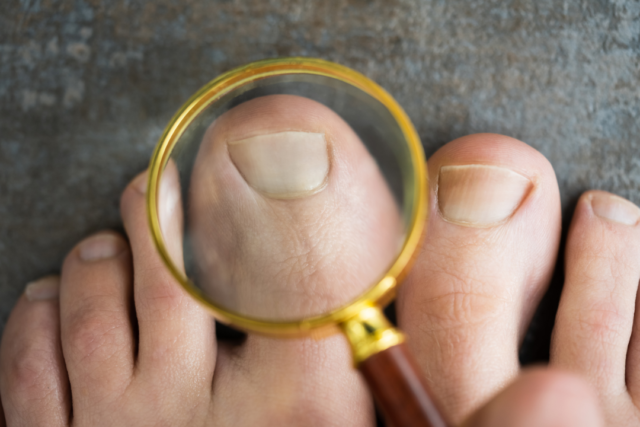
Just like you’re reading this article now, for many people with an ingrown toenail, particularly if it’s their first time with one, they’ll also head online to seek out the best way to treat an ingrown toenail. And after hearing some interesting feedback from our patients in terms of their online search results, we decided to jump online to have a look ourselves – and set the record straight on what we found. And you can bet we were surprised! Here are seven treatment options presented by an article – and our thoughts on these findings.
“Soak the affected foot: Soaking the affected foot in warm water several times a day can help reduce inflammation and ease pain”
While regularly soaking the foot that has your ingrown toenail can help relieve your pain, there are two misconceptions here: first, this effect is very temporary. Next, it doesn’t actually treat, fix or resolve an ingrown toenail. The ingrown portion of your toenail still remains embedded in the surrounding skin, and so the pain and problem will continue to bother you – and is likely to continue to get worse over time.
“Wear comfortable shoes: Wearing comfortable, non-restrictive shoes can help reduce pressure on the affected toenail”
While we always support the advice to wear comfortable shoes, this advice also doesn’t fix the problem of your ingrown toenail. It can help you feel more comfortable and reduce your immediate pain – but it doesn’t remove the painful nail spicule from the skin. This advice also doesn’t clarify what shoes you should wear, beyond being comfortable and being non-restrictive. Specifically, you want shoes that either have a big, spacious toe box for your toe to sit freely in without being pressed on, or ones with an open-toe region.
“Lift the nail: Gently lifting the edge of the ingrown nail with a small piece of cotton or dental floss can help it grow out straight”
If treating an ingrown toenail was as simple as just “lifting” the ingrown piece of the nail out of the skin, then we wouldn’t have a whole clinic dedicated to treating this painful and frustrating condition – and the pain and frustration is often linked to not being able to do anything to ease the pain (beyond temporary medicated relief) at home. When cotton is used to lift the nail, in most cases the offending nail spicule is still left in the skin, continuing to cause ongoing pain and irritation, even if the severity is somewhat reduced. It also doesn’t stop the ingrown nail from recurring in the future.
“Apply antibiotic ointment: Applying an antibiotic ointment to the affected area can help prevent infection”
While it’s true that antibiotic ointment can help prevent infection, which can help ease symptom severity, this also does not fix the problem of your ingrown toenail. This is because antibiotics don’t remove a nail spicule of the skin and don’t treat the underlying cause of an ingrown toenail. We’ve written specifically about antibiotics here.
“Take pain relievers: Over-the-counter pain relievers such as paracetamol or ibuprofen can help reduce pain and inflammation”
It is correct that pain relievers can help reduce pain and inflammation, but once again, offering this temporary relief from your pain and symptoms does not fix or treat your ingrown toenail. The nail spicule still remains deeply embedded in the skin, and only growing further in as time passes.
“See a podiatrist: A podiatrist can trim or remove the ingrown nail and may prescribe antibiotics if there is an infection”
Yes! You absolutely should see a podiatrist for an ingrown toenail. The first piece of advice we can agree on – and yes we can remove your ingrown toenail, though we won’t prescribe you antibiotics for an infection. For those that do need antibiotics, which many of our patients don’t, these are prescribed only by your GP.
“Surgery: In severe or recurrent cases, surgery may be recommended to remove the ingrown nail and prevent it from growing back”
Again, ingrown nail surgery is good advice. This is called a Partial Nail Avulsion (PNA) and involves your podiatrist removing a small section of the nail (including the ingrown portion with the nail spicule) so that you no longer have the nail piercing your skin. We can also apply a chemical to prevent the ingrown edge of the nail from returning. We recommend this for both severe cases, and when this isn’t your first time having an ingrown toenail. So this one is spot on – finally!
So the morale of the story? Don’t trust everything you read on the internet – unless it’s from qualified health professionals that specialise in treating the exact problem you have. If you’re currently struggling with an ingrown toenail, book your appointment with our podiatrists by calling us on 09 523 2333 or book online here.
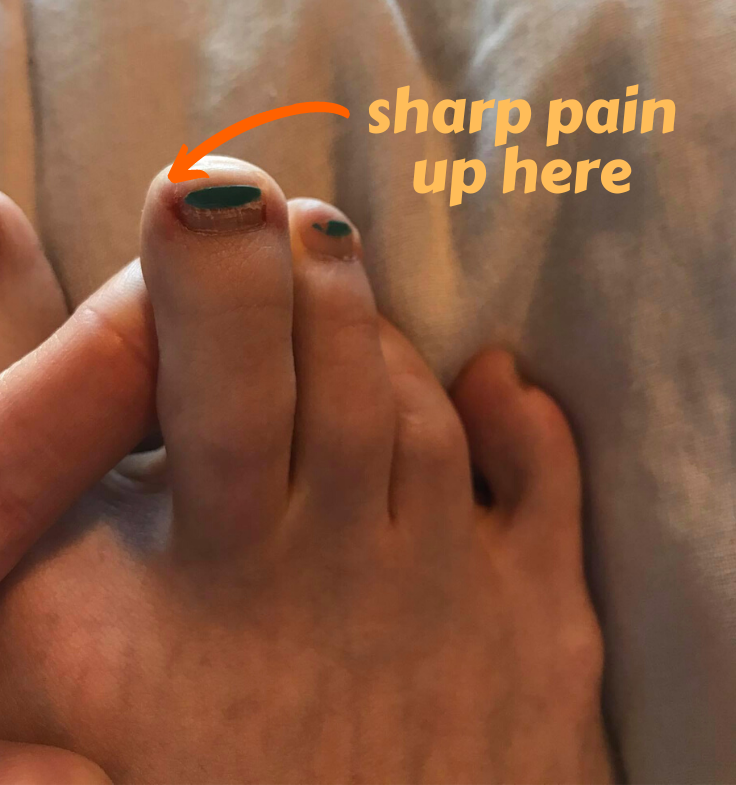
We had a patient come in to see us recently with the tip of her second toe being red, feeling tender and looking a little swollen. She had experienced ingrown toenails previously, and said it felt a little bit like that. Except this time, she had cut her toenails short a week or so prior – and the area that was painful wasn’t immediately down the side of her nail but above it, where the nail used to be before she cut it.
She wasn’t sure what was going on, if it was an ingrown nail, or if it was something else. We thought we’d share what happened in case you’re also feeling like you’ve got pain towards the top of your toe but your nails are trimmed short and the area of the pain isn’t where you’d expect, so you’re wondering whether it could still be an ingrown toenail or what could be causing your toe pain.
The actual toe pictured below (just for reference), about a week after we successfully treated it:
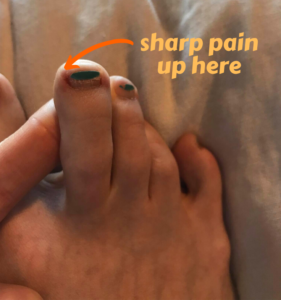
Second toe pain: Our patient’s story
When we examined her toe, it was extremely tender to touch in a particular spot only – and it wasn’t the toenail. (Note: pushing down on the toenail did cause a bit of pain, but only from the way that the pushing affected the painful area at the top of the toe). There was a small indent at the top of the toe where the pain was, and the entire tip of the toe was a little reddened and mildly swollen. Very tender to touch.
Examining the part that had indented, we found two things:
- A small corn in the crease – the skin was harder and firmer than the soft surrounding skin
- A small piece of the nail that had embedded into the nail crease – the crease created in the skin from the previous length of the toenail before it was trimmed
Understanding how this develops, we could see that the nail must have been rubbing against the skin when it was long for some time, which both produced the corn, and encouraged the edge of the nail to become embedded into the skin. Eventually, a small piece of the embedded nail broke off, and was left behind as it was trimmed.
Instant pain relief from treatment
If there’s anything good to come out of this case, it’s that for this patient, her treatment was quick and effective, with the sharp stabbing pain easily instantly after we removed both the embedded nail spicule and the small corn. This is because the swelling, redness and pain was a direct result of the nail spicule still being left behind, which was then made worse by the corn – so once we could remove both of these, the toe would be able to heal and any swelling and pain would subside.
This is a common mistake we see when patients treat their nails at home – they may trim their nails, but forget that while something foreign (and sharp!) is piercing the skin, the wound cannot close and heal. Getting it out can be tricky because the nail spicule can be difficult to see, difficult to remove, and painful when you’re using whatever you have at home to try to help, instead of our fine, specialised podiatric tools.
Within 5 minutes, we were able to remove the nail spicule, remove the corn completely, and then dress the toe. Our patient had immediate relief from the sharp stabbing pain, and while some tenderness lingered as there was still a small wound there, this had subsided by the next morning, along with the redness and swelling.
Our podiatrists make treating all sorts of ingrown toenails easy
We wanted to share this because while many ingrown toenails are ‘textbook’ – big toenail, down the side of the toe – as ingrown toenail specialists, we see plenty of ingrown toenails that are atypical, but that are still very effectively and simply treated.
We’re equipped with all the right tools to make treatment easy and stress-free, and unless you require ingrown nail surgery, can almost always treat and relieve your pain on the day. (If you require surgery we’ll always book you in for it as quickly as possible!).
Book your appointment with us by calling 09 523 2333 or book online here.

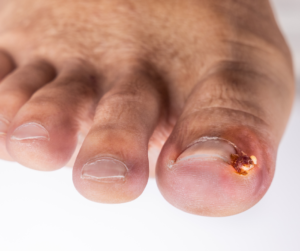 An ingrown toenail develops when a small piece of the nail, or nail spicule, pierces the surrounding skin and begins to grow into the skin, instead of growing out independently alongside the skin. It doesn’t take a big piece of nail to cause you tremendous pain and irritation – think of it like a sharp splinter that gets deeper and gets irritated when you walk or wear closed-in shoes.
The key here is that an ingrown toenail has pierced and entered the skin, as opposed to just rubbing against the skin and causing painful friction. This means that it has created an open wound – even if it’s all the way down the side of the nail. Wherever there is a wound or an opening of the skin, the risk of infection is also always close by – and it may be even closer in this case given the proximity of our feet to the ground and the dirt it carries.
If you’re wondering if the severe pain you’re experiencing from your ingrown toenail is because it’s infected – or if it’s just a deep nail spicule – today we’ve shared some simple signs that may indicate that you have an infection and need more help.
An ingrown toenail develops when a small piece of the nail, or nail spicule, pierces the surrounding skin and begins to grow into the skin, instead of growing out independently alongside the skin. It doesn’t take a big piece of nail to cause you tremendous pain and irritation – think of it like a sharp splinter that gets deeper and gets irritated when you walk or wear closed-in shoes.
The key here is that an ingrown toenail has pierced and entered the skin, as opposed to just rubbing against the skin and causing painful friction. This means that it has created an open wound – even if it’s all the way down the side of the nail. Wherever there is a wound or an opening of the skin, the risk of infection is also always close by – and it may be even closer in this case given the proximity of our feet to the ground and the dirt it carries.
If you’re wondering if the severe pain you’re experiencing from your ingrown toenail is because it’s infected – or if it’s just a deep nail spicule – today we’ve shared some simple signs that may indicate that you have an infection and need more help.
What does an infected ingrown toenail look like?
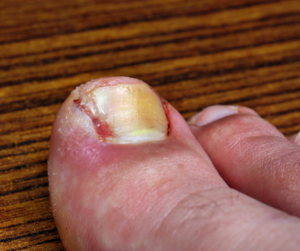 If your ingrown toenail is infected, you may notice:
If your ingrown toenail is infected, you may notice:
- Clear or yellow discharge coming from the side of the nail
- Bleeding from the side of the nail
- Swollen, overgrown or inflamed tissue around the edge of the toenail
- If an abscess develops, you’ll notice a yellow/white fluid-filled pocket
- Redness around the side of the nail
What does an infected ingrown toenail feel like?
- Pain and tenderness around the toenail, especially with the application of any pressure
- Throbbing at the toenail
- Heat or warmth around the nail
- It may feel as if there’s pressure building up beneath the nail
What does an infected ingrown toenail smell like?
Infected ingrown toenails do tend to have a foul or unpleasant smell – which isn’t something that you’d expect from a regular ingrown toenail.
Why infected ingrown toenails are dangerous
Infected ingrown toenails can pose a risk to your health because if your body does not fight off and clear the infection, it can spread or harbour a secondary infection. This may result in the infection spreading to the bone, which is a serious complication and requirements immediate treatment – it may even require surgery.
If you’re unsure – always seek help
It can be difficult to tell an infected ingrown toenail from a non-infected toenail because even without infection, ingrown toenails can swell, and become red and painful. It’s always best to stay safe and put your health first, seeking help at any time that you suspect you may have an infection.
How should you treat an infected ingrown toenail?
Simply put – by seeing your podiatrist! Once an ingrown toenail becomes infected, it requires prompt and effective treatment to both manage the infection and the problem – so that the wound can heal and another infection doesn’t develop.
Here at Perform Podiatry, we treat ingrown toenails in one of three ways:
- Conservative nail care – for first time ingrown toenails, we remove the offending nail spicule if it doesn’t look like the nail will re-grow back and keep causing you pain
- Partial nail avulsion – for recurring ingrown toenails, we remove the nail spicule permanently, using a chemical to prevent the problematic edge of the nail from growing back in the future
- Total nail avulsion – for recurring ingrown toenails that have a secondary problem, like a thickened, damaged or distorted nail – or one with a fungal infection too – we can perform a total nail avulsion. This involves removing the entire nail and allowing it to grow back naturally hopefully without the previous issues.
Worried your ingrown toenail may be infected?
If you need help with a problematic ingrown toenail, our team can help. We’re proud to be one of Auckland’s leading podiatry teams, located within the One Health Building on Remuera Road. Ingrown toenails are one of our specialities.
Book your appointment by calling 09 523 2333 or book online.

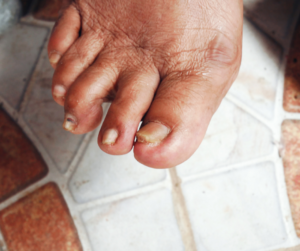 The beauty of summer is that it allows us to get some relief from our ingrown toenails by wearing open-toed sandals and walk around with bare feet, which can also delay the onset of painful symptoms in the first place. In winter and the chilly NZ spring-time? Not so much. Our ingrown toenails can become worse much faster – and for a number of reasons. Today, our podiatry team have shared why your ingrown toenails tend to feel worse faster in the cooler months, what you can be doing to take care of your feet, and our #1 solution for taking care of ingrown toenails for good.
The beauty of summer is that it allows us to get some relief from our ingrown toenails by wearing open-toed sandals and walk around with bare feet, which can also delay the onset of painful symptoms in the first place. In winter and the chilly NZ spring-time? Not so much. Our ingrown toenails can become worse much faster – and for a number of reasons. Today, our podiatry team have shared why your ingrown toenails tend to feel worse faster in the cooler months, what you can be doing to take care of your feet, and our #1 solution for taking care of ingrown toenails for good.
Why the cooler months aggravate our ingrown toenails
Unfortunately, it’s our own actions that tend to leave our nails feeling worse in these months. During winter, many people opt for thicker and warmer, or even dual-layered, socks which can greatly reduce the amount of room we have at the front of our shoes. This cramps our toes, pushing our skin and nails into one another, and makes it easier for the nail to pierce the skin.
 Much like the above, repeatedly wearing enclosed shoes, particularly when they’re tight or narrow, can also produce the same result. As tight, snug-fitting shoes are a common trait of many of our favourite winter sports like skiing, snowboarding and soccer, this leaves us vulnerable to getting that pain, redness, swelling – and sometimes – infection. Activities that have you repeatedly kicking the ball like soccer, or quickly stopping and starting as you push up off the ground can also push into the ingrown nail and aggravate it, causing your symptoms to spring up and worsen.
Much like the above, repeatedly wearing enclosed shoes, particularly when they’re tight or narrow, can also produce the same result. As tight, snug-fitting shoes are a common trait of many of our favourite winter sports like skiing, snowboarding and soccer, this leaves us vulnerable to getting that pain, redness, swelling – and sometimes – infection. Activities that have you repeatedly kicking the ball like soccer, or quickly stopping and starting as you push up off the ground can also push into the ingrown nail and aggravate it, causing your symptoms to spring up and worsen.
Tips for taking care of your ingrown nails and feet
To help care for your ingrown nails over the cooler months, especially when trying to prevent them from recurring, we recommend:
- Remembering that shoes have width sizing, not just length sizing. Opt for shoes with a wider toe box that will accommodate thicker socks and won’t push your toenail and surrounding skin into one another
- Keeping your nails trimmed, and trimming them straight across using proper nail tools. The shorter the nail, the more space there is in the shoe, and the lesser the chance of irritating the toenails. Using proper nail-cutting tools will help reduce the likelihood of leaving little nail spicules behind that can turn into ingrown toenails
- Keeping your feet clean and clearing any build-up from down the sides of your toenails. You already know that dirty feet can encourage the build-up of bacteria and other germs that can irritate the nails – and lead to an infection if an ingrown toenail develops. Regularly clearing any build-ups of dead skin or dirt down the sides of (and beneath) the nails will also help reduce some of pressure which may contribute to ingrown toenails, while helping keep your feet clean
- Airing your toes. When you get home, give your toes some air and some space. This will help relieve some pressure, while encouraging your feet to dry and discouraging any odour or harmful skin breakdown which may cause damage make you vulnerable to infection
- Getting your ingrown toenail treated early, and doing it right. There’s a certain way to take your ingrown toenail from 0 to 100 in quick speed – and that’s digging down the side of the nail yourself to try to remove your ingrown toenail. Often, the offending and penetrating nail spicule is small, deep and very difficult to see and feel (without the right equipment!). Digging at it often just makes it worse, and quickly amps up your painful symptoms. Getting it treated by a skilled podiatrist while it’s still a mild ache and not a sharp, shooting pain, will help you have the least pain and the best results
Permanent relief from ingrown toenails
Unfortunately, ingrown toenails can and do tend to come back – depending on what’s causing them. You can read up on all the causes and symptoms of ingrown toenails here. Here at the Auckland Ingrown Toenail Clinic, as part of Perform Podiatry, we offer a permanent solution to ingrown toenails that not only relieves your current symptoms, but also prevents it from coming back – or we’ll redo the procedure free of charge.
The procedure is called a partial nail avulsion, and it provides a professional, safe and effective solution to frustrating and painful ingrown toenails. It is one of the most common procedures carried out in our clinic, and works to remove the small part of the toenail edge that is piercing the skin and causing your painful symptoms. We see fantastic results from this procedure and have great satisfaction with it, especially as many patients struggle with recurring ingrown toenails for years first.
We love that:
- The procedure is done simply in-clinic
- The total appointment time typically doesn’t exceed 60 minutes (with the procedure time typically around 20 minutes)
- The procedure is performed under local anaesthetic so is pain-free
- You do not need to take any additional time off work/school following the procedure and can go home immediately
- You do not need any special boots or braces while the toe heals
- The procedure causes very little post-procedure discomfort, however, painkillers can be taken should discomfort arise
At the end of the procedure, we dress your toe, provide you with a take-home dressing pack and re-dressing instructions, and continue to monitor your progress to ensure the toe is healing well. You can read more about this procedure and if it’s right for you here
Time to say goodbye to recurring ingrown toenails once and for all?
Trust your foot and nail care to Auckland’s leading podiatry team, situated at the One Health Building on Remuera Road. Book your appointment by calling 09 523 2333 or book online.
When you have diabetes, your risk of foot problems increases significantly. This is because the effects of diabetes on your nerves and blood vessels damages two critical processes when it comes to the feet and legs:
- Your sensation – the ability to feel what’s happening to and around your feet
- Your circulation – the blood flow to and around your feet
When you have an ingrown toenail, this opens you up to a number of vulnerabilities. If you don’t know much about ingrown toenails, what exactly they are or how they’re caused – read this first.
You may not be able to detect the severity of your ingrown toenail – or an infection
 As unpleasant as painful sensations are, our pain response is a very important way for our bodies to gauge what’s going on, when something is wrong, how bad it is, and alert us to take action. When we lightly strain a muscle, we get a mild pain sensation that lets us know to take it easy next time. When we break a bone, we get immense pain that lets us know to avoid putting pressure on the broken bone at all costs, so it doesn’t worsen, and can start to repair.
When our sensation is diminished, we can’t rely on our bodies to get this message to us accurately or efficiently. This leaves us vulnerable to feeling like we may have a mild achy toe, or a very minor ingrown nail that doesn’t require urgent care – whereas in reality it’s already been infected for days and needs to be treated ASAP, before the infection has a chance to reach the bone or we pick up a secondary infection.
As unpleasant as painful sensations are, our pain response is a very important way for our bodies to gauge what’s going on, when something is wrong, how bad it is, and alert us to take action. When we lightly strain a muscle, we get a mild pain sensation that lets us know to take it easy next time. When we break a bone, we get immense pain that lets us know to avoid putting pressure on the broken bone at all costs, so it doesn’t worsen, and can start to repair.
When our sensation is diminished, we can’t rely on our bodies to get this message to us accurately or efficiently. This leaves us vulnerable to feeling like we may have a mild achy toe, or a very minor ingrown nail that doesn’t require urgent care – whereas in reality it’s already been infected for days and needs to be treated ASAP, before the infection has a chance to reach the bone or we pick up a secondary infection.
If you try treating the ingrown nail yourself, it may be difficult to tell if you’ve got it out
One thing we’d expect when the nail spicule is removed from the skin it has grown into is a big feeling of relief, followed by minimal pain when pushing around the side of the nail (compared to what it used to be – you may still have some tenderness from the wound and the swelling). If your sensation is diminished, it may be hard to tell if you’ve removed all of the nail – or only part of it and it’s just going to keep giving you ongoing problems.
The beauty of having your nail spicule treated in our clinic by our podiatrists is that this is something we do every day, so can not only confidently tell when we have removed the entire nail spicule, but are also able to see it much more clearly. We also have the right tools and equipment to do a great job.
It’s worthwhile noting that we always always always recommend that those with diabetes have their ingrown toenails treated by a podiatrist only for your own safety and well-being, however, we know that this isn’t always what happens, hence it’s important to know these risks.
You may worsen the damage
Using home tools to dig around your toenail in an attempt to remove the penetrating nail spicule is a sure way to worsen the damage and make the wound bigger – leaving your body with a much bigger job when it comes to repairing the damage and closing the wound, not to mention increasing your risk of picking up an infection from the size of the wound. This is particularly important when you consider that…
You may have problems with healing the ingrown nail
Good, healthy blood flow is essential in any healing and repair process in the body. As this is impaired in diabetes sufferers, you don’t get the same volume of blood, oxygen and nutrients to the damaged site, which means closing the wound and repairing the damage can be a longer and more laborious process. It’s much the same as diabetic foot ulcers – which many people struggle and often have to have additional treatments and therapies to allow them to heal.
Your body may not be able to fight an ingrown toenail infection effectively
What else does a healthy blood supply carry with it? All the cells that fight infection and help keep us safe. When your body can’t do this effectively, the infection can worsen, spread, you can pick up a secondary infection, and generally, your health can suffer. All this without mentioning the pain and discomfort it can cause!
The best advice: Get your ingrown toenail taken care of by a podiatrist
Taking all the points above into consideration, this is why it’s incredibly important to have your ingrown toenail taken care of by a podiatrist when you have diabetes – and also when you don’t have diabetes. Don’t take our word for it – this is the official recommendation from Diabetes New Zealand, as well as Diabetes Australia and every diabetes resource we’ve ever seen worldwide.
Don’t put your feet at risk – book your appointment online here or call us on (09) 523 2333.







 An ingrown toenail develops when a small piece of the nail, or
An ingrown toenail develops when a small piece of the nail, or  If your ingrown toenail is infected, you may notice:
If your ingrown toenail is infected, you may notice:
 The beauty of summer is that it allows us to get some relief from our ingrown toenails by wearing open-toed sandals and walk around with bare feet, which can also delay the onset of painful symptoms in the first place. In winter and the chilly NZ spring-time? Not so much. Our ingrown toenails can become worse much faster – and for a number of reasons. Today, our podiatry team have shared
The beauty of summer is that it allows us to get some relief from our ingrown toenails by wearing open-toed sandals and walk around with bare feet, which can also delay the onset of painful symptoms in the first place. In winter and the chilly NZ spring-time? Not so much. Our ingrown toenails can become worse much faster – and for a number of reasons. Today, our podiatry team have shared  Much like the above, repeatedly
Much like the above, repeatedly 